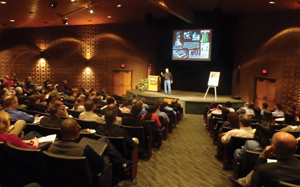
|
I had the opportunity to attend the Detroit Society for Coatings Technology’s FOCUS conference on May 2, in Troy, MI. This year’s theme was “Coatings – More Than Just Paint,” and featured presentations by NASA, Ford, Axalta Coatings Systems (formerly DuPont), Eastman, Momentive, BASF and PPG. The opening keynote speaker, John Miller, Director of Michigan State University’s Executive MBA program, spoke on innovation. A product development leader at Chrysler for 25 years and a professor of graduate-level courses in innovation at MSU and Detroit Mercy since 2001, Miller had some great insights into this topic.
Some time ago, Miller wondered why some companies are more successful than others. He looked at the product development processes of various companies in a variety of industries and found that they were basically all the same. Then he started looking closely at some very successful organizations, such as Apple, Intuit and Southwest Airlines, and he started to see “that there was a little magic going on at these companies.” He realized that these companies treat innovation as a core competence of the organization, not just a fad or a strategy. In these organizations, every employee believes that their ideas can influence the destiny of the company. Every person (not just the R&D department) is trained in innovation skills. Everyone can get funding, talent and management support to test new ideas. These companies observe their customers, and begin to understand their patterns, trends and behaviors.
For Miller, the fundamental principle of innovation is creating value and new market opportunities. It is not about creating something that costs more. His definition of innovation is “the passion to solve problems of unmet customer needs.” Companies that are successful at creating truly innovative products and services have transformed their organizations to be passionately focused on creating value for their customers. They innovate by doing the following:
- Challenge paradigms (“Why do we do it this way, and can we do it differently?”);
- Harness discontinuities (look for trends and patterns in human behavior);
- Leverage competencies (build intellectual capital within their companies); and
- Discover unarticulated customer needs.
I am sure that everyone who attended this keynote presentation went back to the office with some new ideas for their managers and the question, “How innovative is our company?” Without innovation today, we really cannot do much more to create products that meet the regulations and provide quality to the consumer at no increase in cost.



Report Abusive Comment